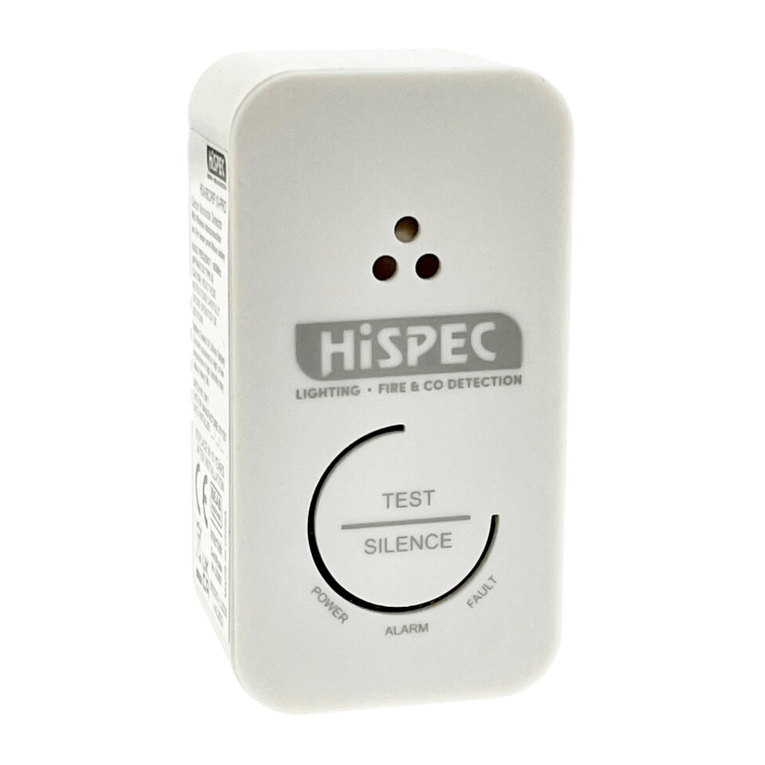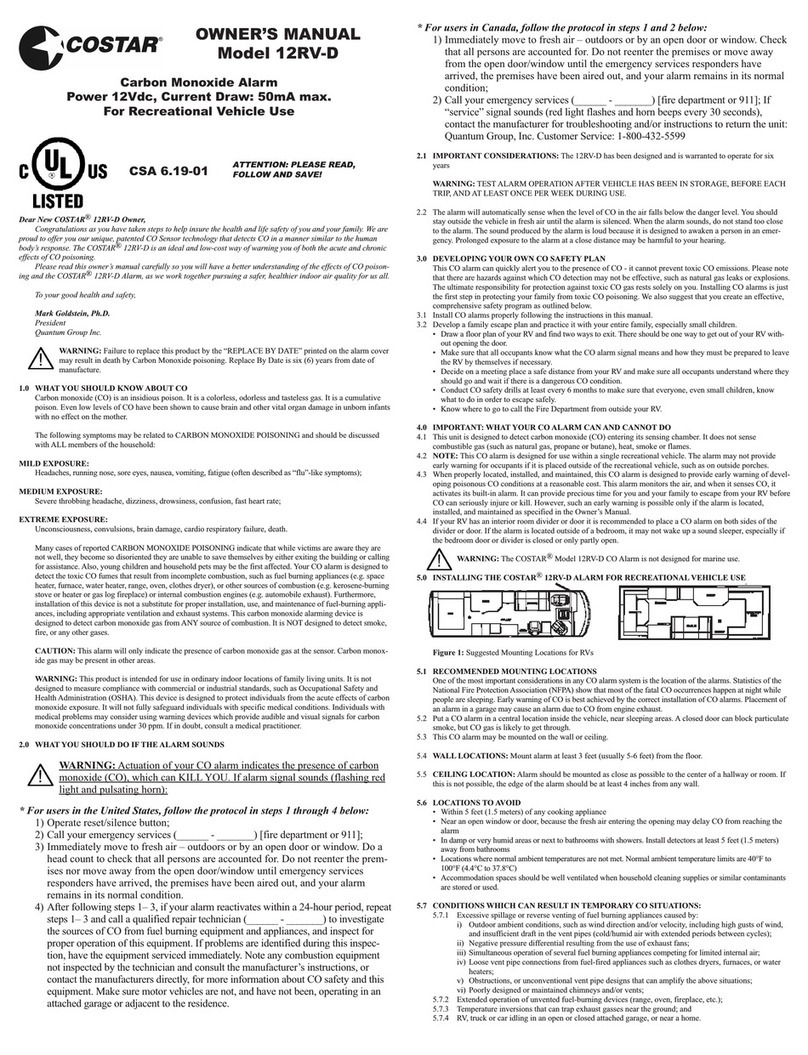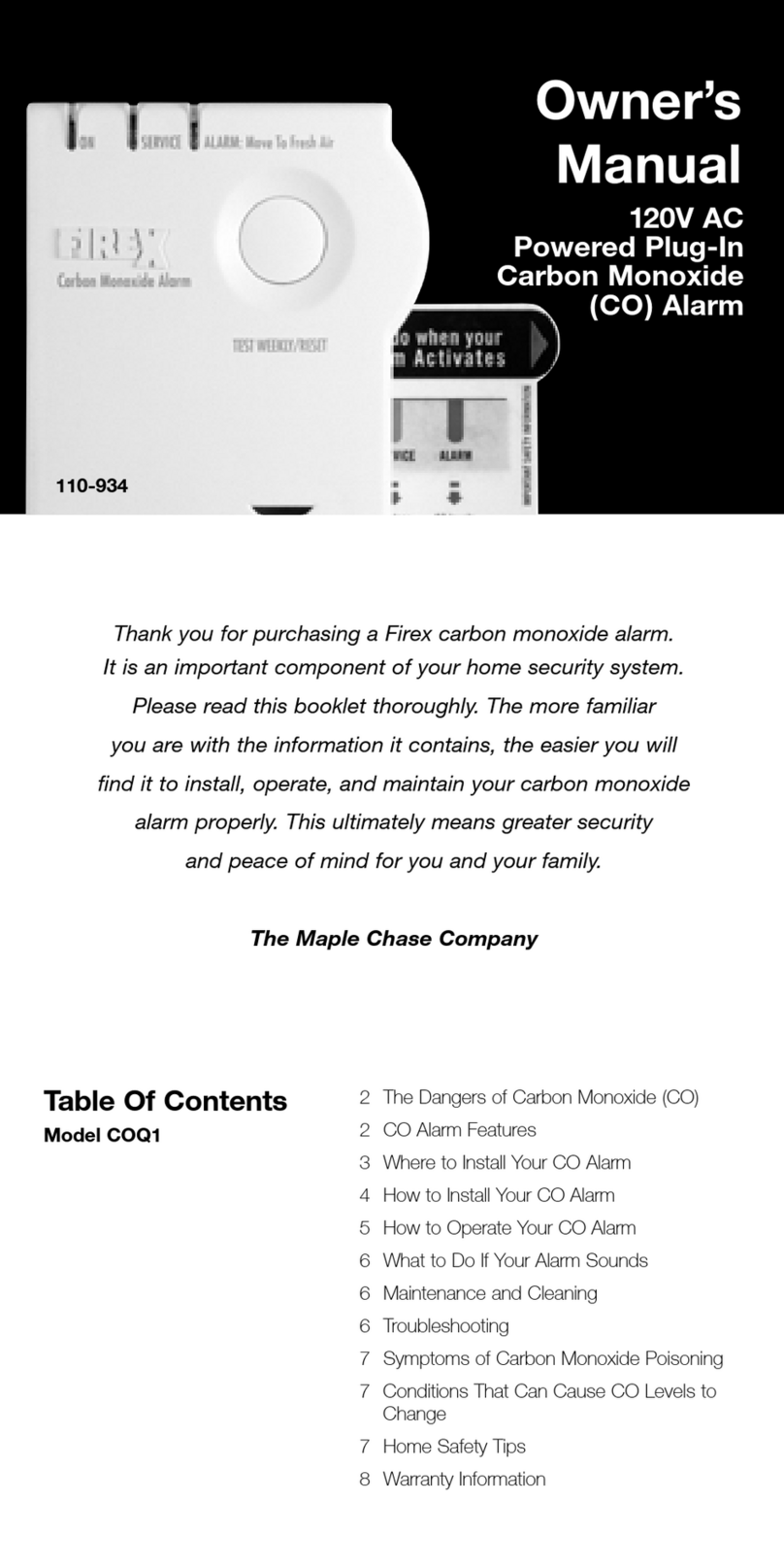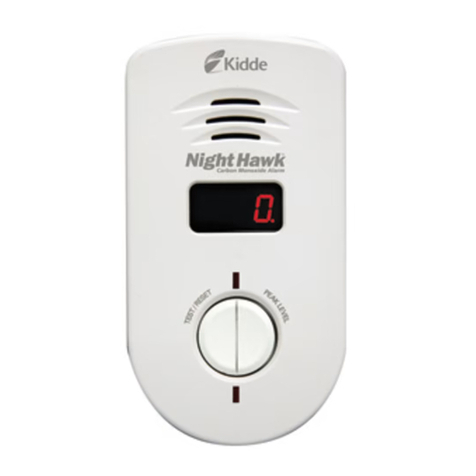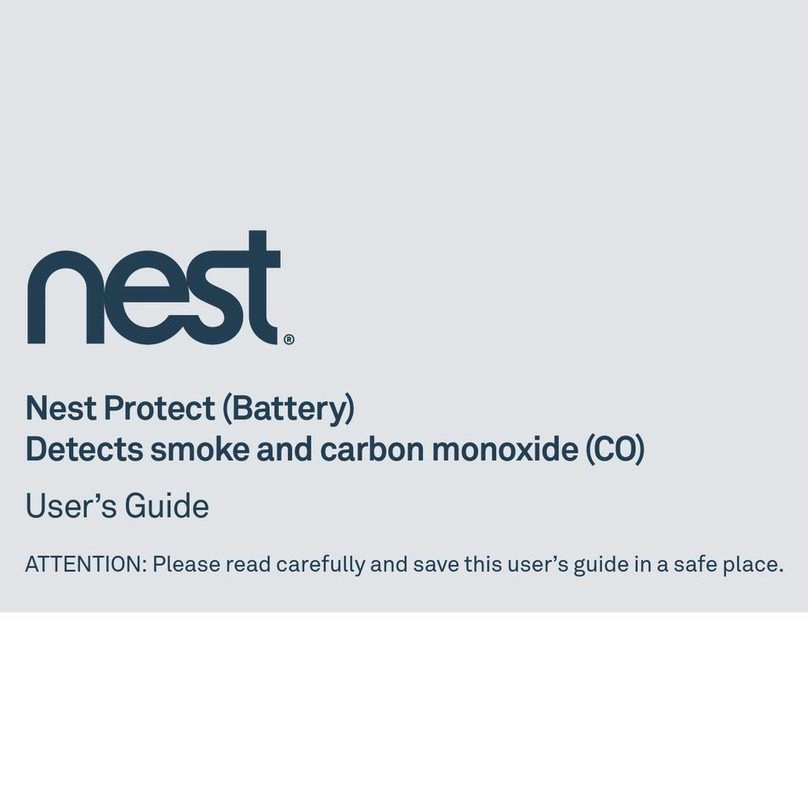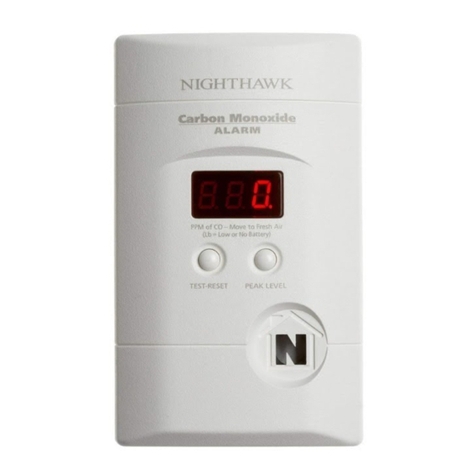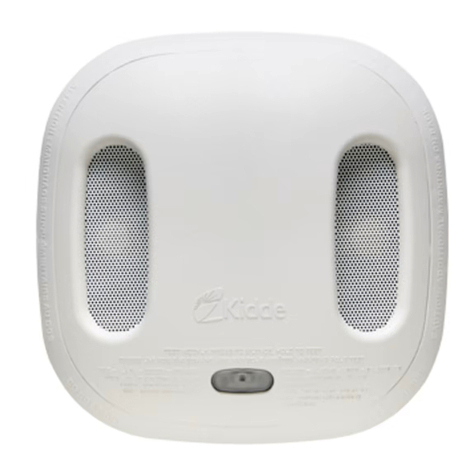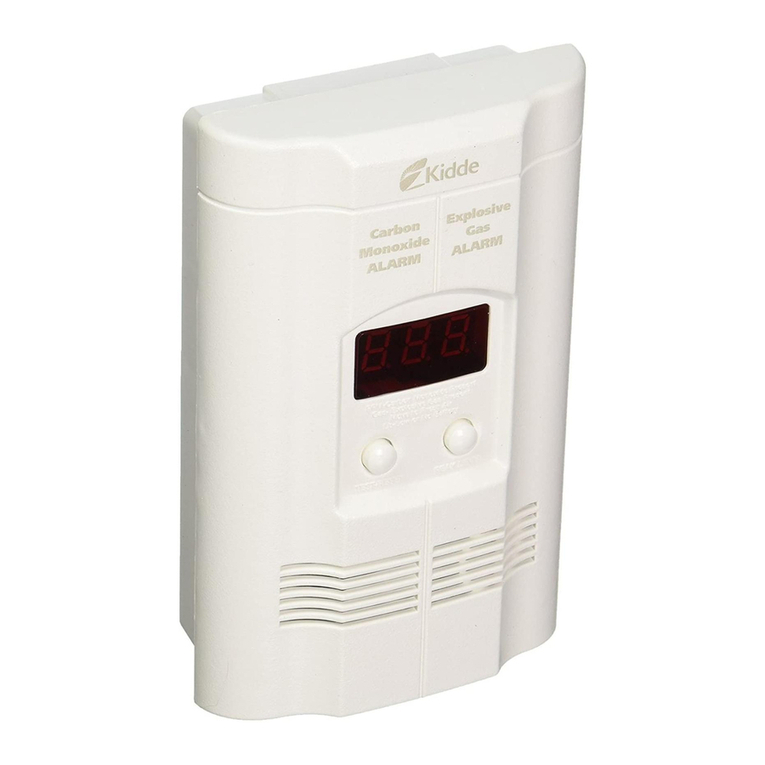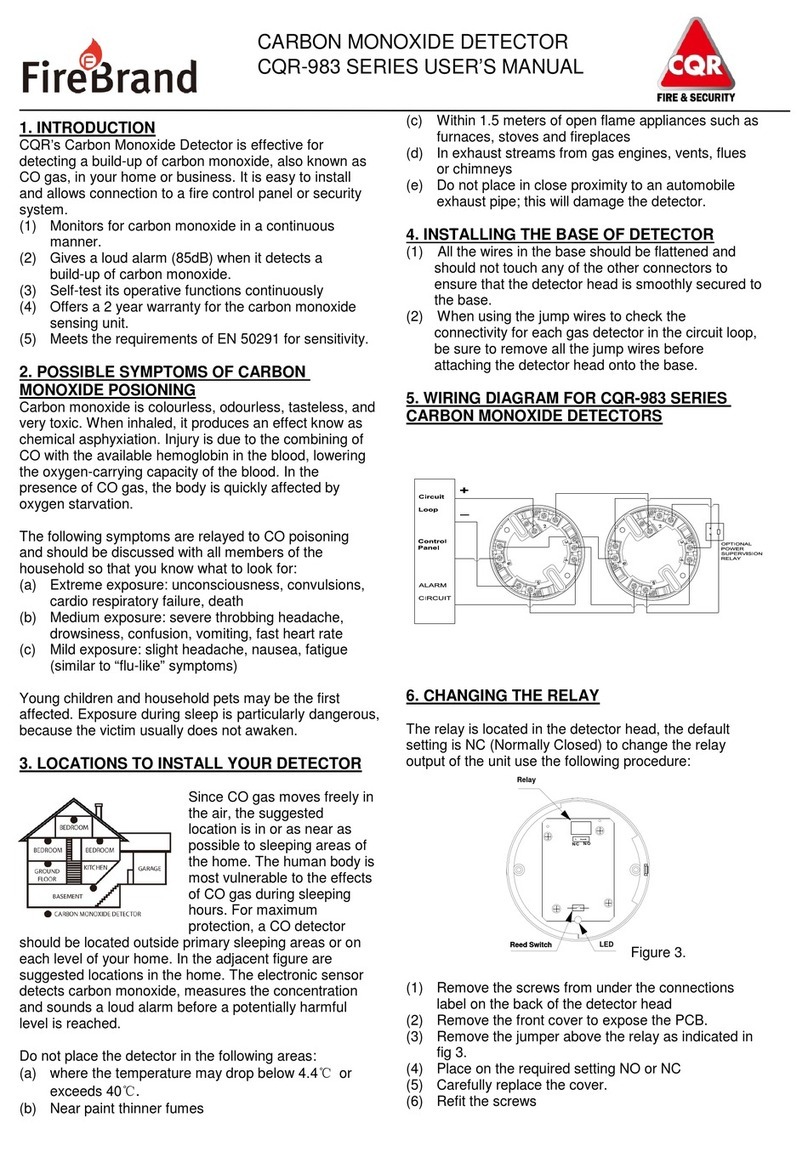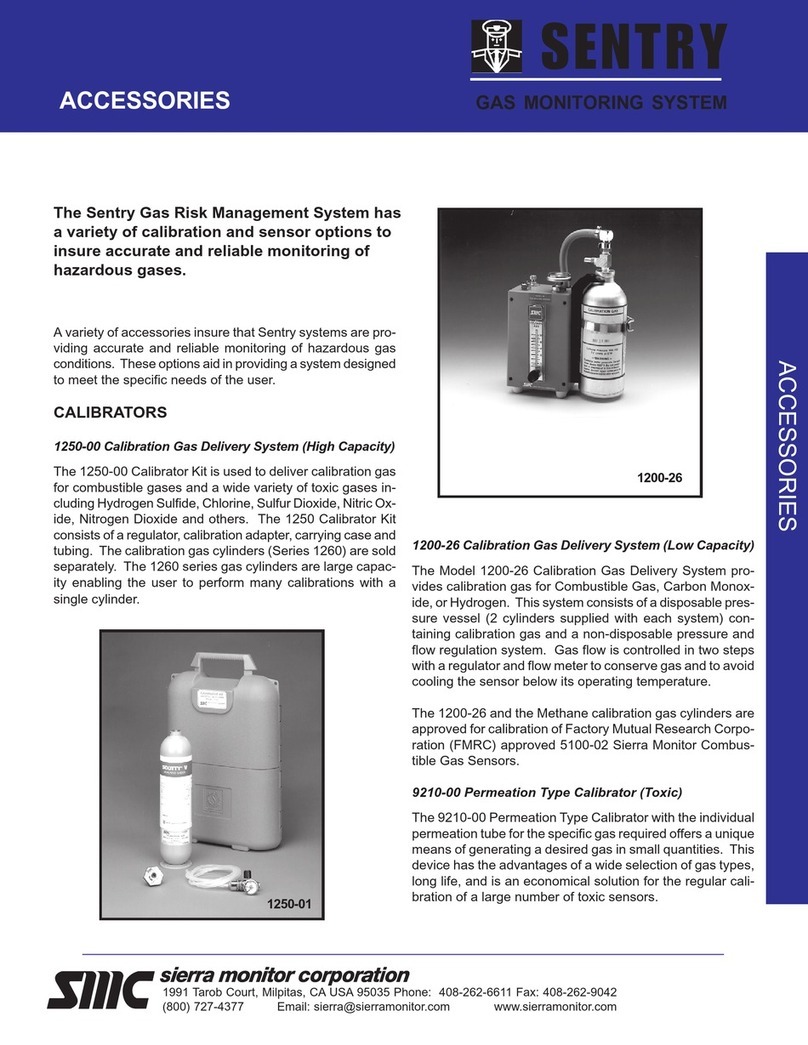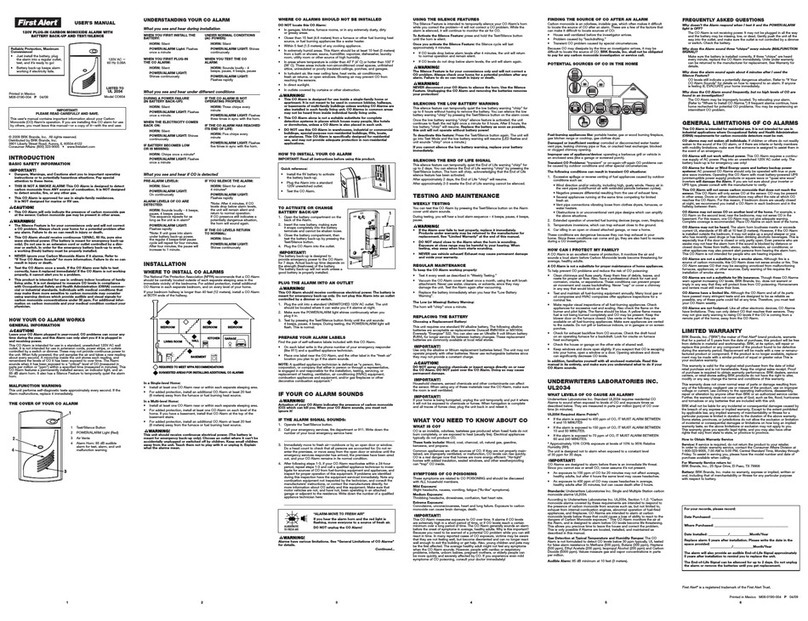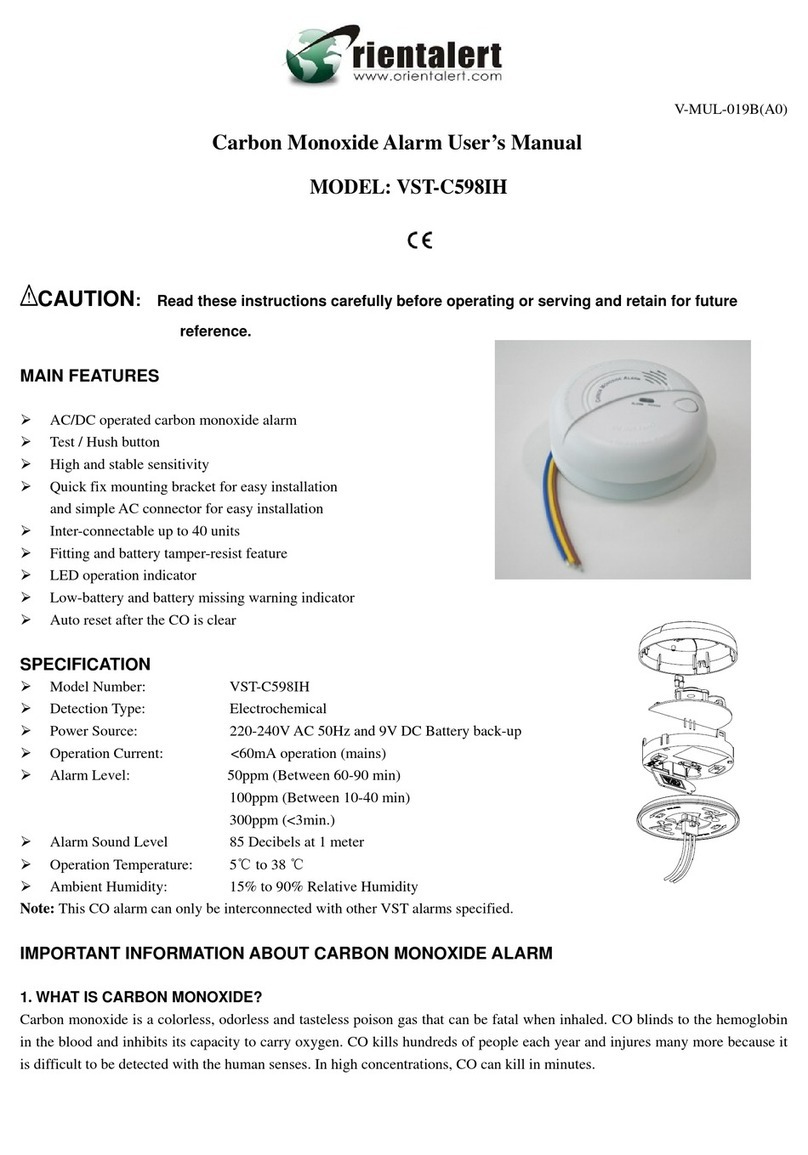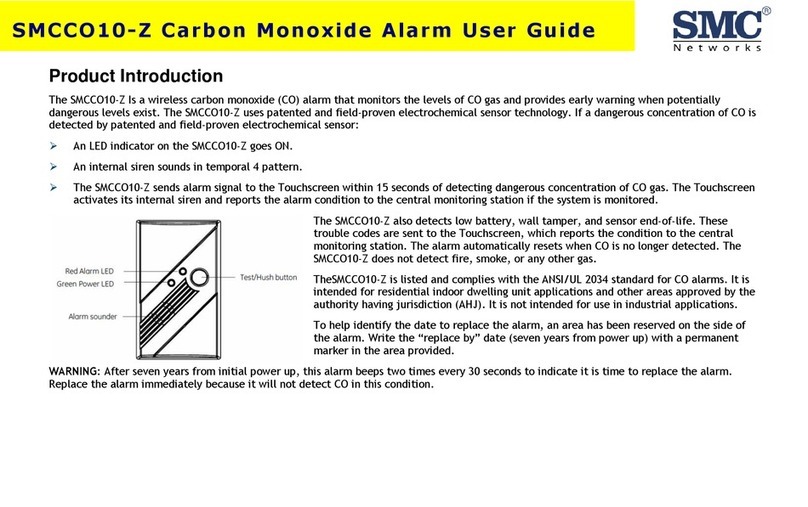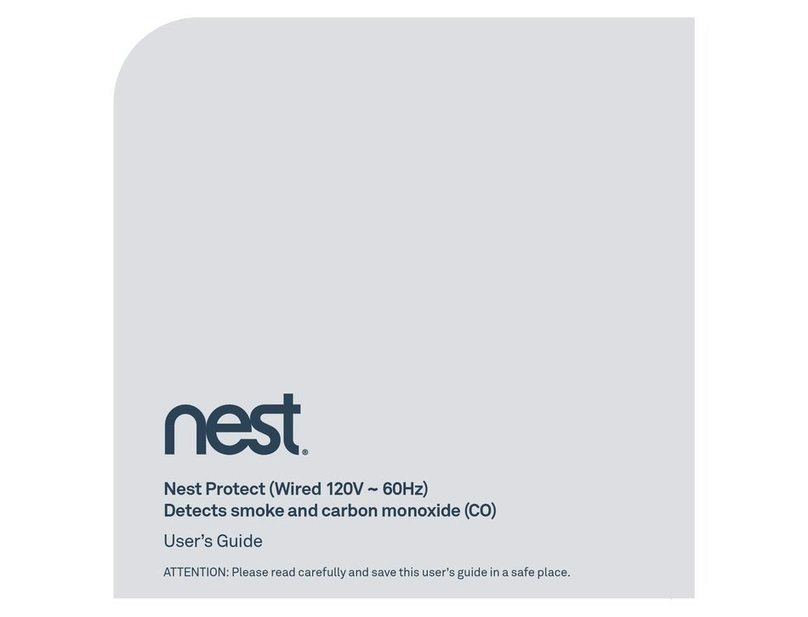Hi-Spec HSA/BC User manual

BATTERY POWERED
CARBON MONOXIDE ALARM
MODEL : HSA/BC
Main Features :
Electrochemical Sensor
Easy Installation, Portable, Ideal For
Travelling
Test / Reset Button
Low Battery Warning
Self-Test Function
Supplied With Wall Plugs & Screws
Cannot Be Fitted With Battery Missing
Approved to EN50291-1:2010+A1:2012
This instruction leaflet contains important information on
the correct installation and operation of your Carbon
Monoxide (CO) alarm. Read this leaflet fully before
attempting installation and retain for future reference.
SPECIFICATIONS
Power Source : 9V Battery (Carbon Zinc Gold Peak 1604E,
Or, (Alkaline Gold Peak 1604A, Duracell
MN1604, Energizer 52)
Type of Gas sensed : Carbon Monoxide
Sensor Life : 3 Years
Alarm Response Time : 50 PPM (Between 60 to 90 min.)
100 PPM (Between10 to 40 min.)
300 PPM (Less than 3 min.)
Operation Temperature : -10oC ~ 40oC
Ambient Humidity : 10%-90%
Horn Level : 85 Decibels at 1 m
Battery Life : 1 year minimum
WHAT IS CARBON MONOXIDE
Carbon Monoxide (CO) is an insidious poison that is released
when fuels are burnt. It is a colorless, odorless, tasteless gas and
therefore very difficult to detect with the human senses. CO kills
hundreds of people each year and injures many more. It binds to
the hemoglobin in the blood and reduces the amount of oxygen
being circulated in the body. In high concentrations, CO can kill in
minutes.
CO is produced by the incomplete combustion of fuels such as
wood, charcoal, coal, heating oil, paraffin, petrol, natural gas,
propane, butane etc.
Common Sources of CO:
Attached garages
Oil and Gas furnaces
Wood stoves
Barbecues
Wood and gas fireplaces
Gas appliances
Portable generators
Gas or kerosene heaters
Clogged chimneys
Cigarette smoke
LOCATING THE CO ALARM
Carbon Monoxide alarm is designed to detect the toxic
CO fumes
that result from incomplete combustion, such as those
emitted
from appliances, furnaces, fireplace and auto exhaust.
Ideally, a CO alarm should be installed in every room containing a
fuel burning appliance. Additional apparatus may be installed to
ensure that adequate warning is given for occupants in other
rooms , by locating apparatus in:
remote rooms in which the occupant spend considerable time
whilst awake and from which they may not be able hear an
alarm from apparatus in another part of the premises, and
every
sleeping
room.
However, if there is a fuel burning appliance in more than one
room and the number of CO
alarm is limited, the following points
should be taken into consideration when deciding on the best
location:
An
apparatus should be located in a room containing a flueless
or open-flued appliance.
If there is an appliance in a room where people spend most
time,
an
apparatus should be placed in that room.
If there is an appliance in a room where people sleep,
an
apparatus should be placed in that room.
In a bedsit, the apparatus should be placed as far from the
cooking appliances as
possible
but near to where the person
sleeps.
If the appliance is in a room not normally used, such as boiler
room, the apparatus should be placed just outside the room so
that
the alarm will be heard more easily.
CAUTION
This alarm will only indicate the presence of carbon monoxide
gas at the sensor. Carbon Monoxide gas may be present in
other areas.
This carbon monoxide alarm is designed to detect carbon
monoxide gas from ANY source of combustion. It is NOT
designed to detect smoke, fire or any other gas.
POSITIONING THE CO ALARM
Carbon Monoxide has a similar density to warm air and can be
fitted in various locations.
Apparatus located in the same room as a fuel-burning
appliance:
If the apparatus is located on a wall, it should be located at a
height greater than the height of any door or window but at
least 150 mm from the ceiling. If the apparatus is mounted on a
ceiling, it should be at least 300 mm from any wall.
The apparatus should be at a horizontal distance of between 1
m and 3 m from the potential source.
If there is partition in a room, the apparatus should be located
on the same side of the partition as the potential source.
In rooms with sloped ceilings, the apparatus should be located
at the high side of the room.
Apparatus located in sleeping rooms and in rooms remote
from a fuel burning appliance:
The apparatus should be located relatively close to the
breathing zone of the occupants.
Areas to be avoided include the following:
Situations where the temperature may drop below -10oC or
exceed 40oC
In a damp or humid area
Any area where high levels of dusty, dirty or greasy emissions
could contaminate or clog the sensor.
Where the air flow to the apparatus would be obstructed by
curtains or furniture.
Next to a door or window or in the path of air discharged from a
furnace / air conditioning vent or ceiling fan.
Outside the building
Directly above a sink or cooker
In or below cupboard
The following conditions can result in transient CO situations
in the home:
Excessive spillage or reverse venting of fuel burning
appliances caused by:
1.) Outdoor ambient conditions such as wind direction
and/or velocity, including high gusts of wind; heavy
air in the vent pipes (cold/humid air with extended
periods between cycles).
2.) Negative pressure differential resulting from the use
of exhaust fans.
3.) Simultaneous operation of several fuel burning
appliances competing for limited internal air.
4.) Vent pipe connection vibrating loose from clothes
dryers, furnaces, or water heaters.
5.) Obstructions in or unconventional vent pipe designs
which amplify the above situations.
Extended operation of unvented fuel burning devices
(range, oven, fireplace, etc.).
Temperature inversions which can trap exhaust gases near
the ground.
Car idling in an open or closed attached garage, or near a
home.
WARNING
This carbon monoxide alarm is designed for indoor use only.
Do not expose to rain or moisture. It will not protect against
the risk of carbon monoxide poisoning when the battery has
drained.
Do not open or tamper with the alarm as this could cause
malfunction.
Installation of the apparatus should not be used as a substitute for
proper installation, use and maintain of fuel burning appliances
including appropriate ventilation and exhaust systems.
INSTALLING THE CO ALARM
This CO alarm is powered by a battery and requires no additional wiring.
It can either be free-standing or installed on the wall using the fixings
provided.
Wall mount installation:
Having established the mounting location ensure
that there is no electrical wiring or pipe work in the area adjacent
to the mounting surface.
Mark the two mounting hole locations.
Drill holes in the positions marked.
Insert wall plugs into the drilled holes.
Screw mounting bracket to mounting surface. DO NOT OVER
TIGHTEN.
Insert a 9V battery firmly into battery compartment on the rear of
the detector. NOTE POLARITY OF CONNECTIONS.
NOTE –For the safety of the end user the CO alarm cannot be
fitted without its battery.
Assemble the alarm onto the mounting plate
OPERATING YOUR CO ALARM
Normal Operation
After battery installation, the green LED will flash five times. Then the
unit will enter into the normal operation mode. When no carbon
monoxide is present, the green light will flash approximately once per
minute and is an indication that your alarm is powered and functional.
During normal operation the CO alarm perform a self-check test every
minute.
IMPORTANT: After installation, test your alarm (see the paragraph
“Test your CO alarm”
Alarm Condition
When the apparatus detects dangerous levels of CO gas, it will give an
alarm signal. The red LED will flash and the buzzer will chirp 6 times
simultaneously every second.
After 30 minutes, when the apparatus remains alarming, the red LED will
flash and the buzzer will chirp 6 times simultaneously every minute.
During alarming, the green LED will flash once every 10 seconds.
CO LEVEL (PPM) RESPONSE TIME (MIN)
50 60-90
100 10-40
300 < 3
WARNING
This product may not alarm at low carbon monoxide levels.
Individuals with medical problems may consider using warning
devices which provide audible signals for carbon monoxide
concentrations under 30 PPM.
Low Battery Signal
A fresh battery should last for one year. In case the battery is at the end
of its life, the apparatus will sound a short chirp with a yellow LED flash
simultaneously in every minute. The battery should be replaced
immediately. This low voltage warning will be given for at least 30 days.

Under normal operating conditions, the batteries will last a minimum of
one year.
Note: Constant exposure to high or low humidity may reduce
battery efficiency.
Unit Malfunction
Your CO alarm performs an internal self-diagnosis every minute to make
sure that it is functioning properly. In the rare event that your alarm
malfunctions, the apparatus will sound a double short chirp and the
yellow LED flash simultaneously in every minute. In this case the alarm
must be replaced.
Never ignore a CO unit’s alarm. A true alarm is an indication of potentially
dangerous levels of carbon monoxide. CO alarms are designed to alert
you to the presence of carbon monoxide before an emergency, before
most people would experience symptoms of carbon monoxide poisoning,
giving you time to resolve the problem calmly.
TESTING YOUR CO ALARM
It is recommended that you test your CO alarm once a month to ensure
the alarm is working correctly.
Test the unit by depressing the Test/Reset button. The red LED will flash
and the buzzer will chirp 6 times simultaneously. Then the unit will enter
into the normal operation mode and the green light should flash once a
minute.
WHAT TO DO IF THE ALARM SOUNDS
WARNING
Actuation of your CO alarm indicates the presence of carbon
Monoxide (CO), which can KILL YOU.
If alarm signal sounds:
1. Immediately move to fresh air –outdoors or by an open
door/window. Do a head count to check that all persons are
accounted for.
2. Where possible turn off all fuelled appliances and stop using them.
3. Call your emergency services
4. Do not re-enter the premises nor move away from the open
door/window until emergency services responders have arrived, the
premises have been aired out, and your alarm remains in its normal
condition.
5. Call a qualified appliance technician to investigate for sources of
CO from fuel burning equipment and appliances, and inspect for
proper operation of this equipment. If problems are identified during
this inspection have the equipment serviced immediately. Note any
combustion equipment not inspected by the technician and consult
the manufacturers’instructions, or contact the manufacturers
directly, for more information about CO safety and this equipment.
Make sure that motor vehicles are not, and have not been,
operating in an attached garage or adjacent to the residence.
MAINTAINING YOUR CO ALARM
Your alarm will alert you to potentially hazardous CO concentrations in
your home when maintained properly. To maintain your alarm in proper
working order, it is recommended that you:
Test your alarm at least once a month.
Clean the outside case regularly to prevent dust or dirt build up in
the slots. DO NOT USE CLEANING AGENTS, BLEACH, POLISH
OR ANY CHEMICALS. Chemicals can permanently damage or
temporarily contaminate the sensor. Simply wipe with a damp
cloth OR a clean tissue.
Do not paint the CO alarm
NOTE - If you will be staining or stripping wood floors or furniture,
painting, wall-papering, or using aerosols or adhesives, remove
the CO alarm to a remote location before in order to prevent
possible damage to or contamination of the sensor.
The following is a list of substances which, at high levels, can
affect the sensor and may cause a nuisance alarm that is not a
carbon monoxide alarm.
Methane, propane, iso-butane, ethylene, ethanol, alcohol, iso-
propanol, benzene, toluene, ethyl acetate, hydrogen, hydrogen
sulfide, sulfur dioxides.
Also most aerosol sprays, alcohol based products, paints,
solvents, adhesives, hair sprays, after shaves, perfumes and some
cleaning agents.
BATTERY REPLACEMENT
If the CO Alarm emits a short ‘beep’ once a minute the battery is at
the end of its life and should be replaced immediately. This low
voltage warning will be given for at least 30 days.
Remove the battery from the compartment.
Insert a new, healthy 9V battery. NOTE POLARITY OF
CONNECTIONS.
Using the Push-to-Test button to test the CO Alarm. See
“TESTING YOUR CO ALARM”
Reattach the CO alarm to the mounting plate.
WARNING: DANGER OF EXPLOSION IF BATTERY IS
INCORRECTLY REPLACED. THE USE OF BATTERIES OTHER
THAN THOSE RECOMMENDED ON THE BACK OF THE CO
ALARM MAY BE DETRIMENTAL TO ITS OPERATION
SYMPTOMS OF CO POISONING
The following symptoms may be related to CO poisoning:
35 ppm The maximum allowable concentration for
continuous exposure for healthy adults in any
8 hour period.
200 ppm Slight headaches, fatigue, dizziness, nausea
after 2-3 hours
400 ppm Frontal headaches within 1-2 hours, life
threatening after 3 hours.
800 ppm Dizziness, nausea and convulsions within 45
minutes. Unconsciousness within 2 hours. Death
within 3 hours.
1600 ppm Headache, dizziness and nausea within 20
minutes. Death within 1 hour
6400 ppm Headache, dizziness and nausea within 1-2
minutes
The following symptoms re related to CARBON MONOXIDE
POISONING and are to be discussed with ALL members of the
household:
Mild Exposure: Slight headache, nausea, vomiting, fatigue (often
described as “flu-like”symptoms).
Medium Exposure: Severe throbbing headache, drowsiness,
confusion, fast heart rate.
Extreme Exposure: Unconsciousness, convulsions, cardio-
respiratory failure, death.
Many cases of reported CARBON MONOXIDE POISONING
indicate that while victims are aware they are not well. They
become so disoriented they are unable to save themselves by
either the building or calling for assistance. Young children and
household pets are typically the first affected.
The apparatus may not prevent the chronic effects of carbon
dioxide exposure and that the apparatus will not fully
safeguard individuals at special risk.
IMPORTANT SAFEGUARDS
Installation of your CO alarm is only one step in your safety plan.
Educate yourself and family to the sources and symptoms of CO
poisoning and how to use your carbon monoxide alarm:-
Replace the battery immediately once depleted
Buy appliances accepted by a recognized testing
laboratory.
Install the appliances properly, following the manufacturers’
instructions.
Have installations done by professionals.
Have your appliances checked regularly by a qualified
serviceman.
Clean chimneys and flues yearly.
Make regular visual inspections of all-fuel-burning
appliances.
Check appliances for excessive rust and scaling.
Do not barbecue indoors, or in attached garage.
Open windows when a fireplace or wood burning stove is
in use.
Be aware of CO poisoning symptoms.
DO NOT:
Burn charcoal inside your home, RV, camper, tent or cabin
Install, convert or service fuel burning appliances without
proper knowledge, skill and expertise
Use a gas range, oven or clothes dryer for heating
Operate unvented gas burning appliances using kerosene
or natural gas in closed room
Operate gasoline powered engines indoors or in confined
areas
Ignore a safety device when it shuts an appliance off
Ignore any warning from your CO alarm
END OF UNIT LIFE
The apparatus will operate up to 3 years under normal use. A
fresh battery should last for at least one year. The apparatus must
be replaced when a fault warning signal is given.
NOTE: With normal use the battery will last at least 1 year.
However, battery life will be reduced if either a fault occurs
with the battery or the apparatus remains in alarm for long
periods of time.
THIS PRODUCT CANNOT BE REPAIRED –IF THE UNIT IS
TAMPERED WITH IT WILL INVALIDATE THE GUARANTEE. IF
THE UNIT IS FAULTY PLEASE RETURN IT TO YOUR
ORIGINAL SUPPLIER WITH YOUR PROOF OF PURCHASE.
YOUR CO ALARM WARRANTY
This CO Alarm, excluding battery, is warranty to be free from defects in
materials and workmanships under normal residential use and service
for a period of (3) years from the date of purchase. The company will not
be obligated to repair or replace parts that are found to be in need of
repair because of misuse, damage or alterations occur after the date of
purchase. Send the CO Alarm with proof of purchase, postage and
return postage prepaid, to local distributor. The liability of the company
arising from the sale of this CO Alarm shall not in any case exceed the
cost of replacement of the product and in no case shall the company be
liable for consequential loss or damages resulting from the failure of the
product.
HISPEC ELECTRICAL PRODUCTS LTD. SHALL HAVE NO
LIABILITY FOR ANY PERSONAL INJURY OR PROPERTY
DAMAGE, OR ANY SPECIAL INCIDENTAL, CONTINGENT
OR CONSEQUENTIAL DAMAGE OF ANY KIND RESULTING
FROM A FIRE. THE EXCLUSIVE REMEDY FOR BREACH OF
THE LIMITED WARRANTY CONTAINED HEREIN IS THE
REPAIR OR REPLACEMENT OF THE DETECTIVE
PRODUCT AT HISPEC ELECTRICAL PRODUCTS LTD.
OPTION. IN NO CASE SHALL HISPEC ELECTRICAL
PRODUCTS LTD.’S LIABILITY UNDER ANY OTHER
REMEDY PRESCRIBED BY LAW EXCEED THE PURCHASE
PRICE. YOUR HEAT ALARMS IS NOT A SUBSTITUTE FOR
PROPERTY, DISABILITY, LIFE OR OTHER INSURANCE OF
ANY KIND. APPROPRIATE COVERAGE IS YOUR
RESPONSIBILITY. CONSULT YOUR INSURANCE AGENT.
This does not affect your statutory rights.
This alarm is only suitable for residential dwellings and is not
suitable for commercial or industrial use.
Waste electrical products should not be disposed of with normal
household waste. Please recycle where facilities exist. Check
with your Local Authority or retailer for recycling advice. New
regulation will encourage the recycling of Waste from Electrical
and Electronic Equipment (European "WEEE Directive"
effective August 2005).
Hispec Electrical Products Ltd
www.hispec.co.uk
Other Hi-Spec Carbon Monoxide Alarm manuals

